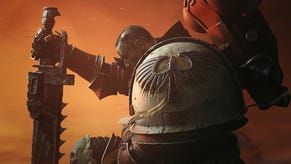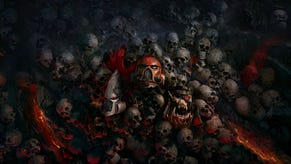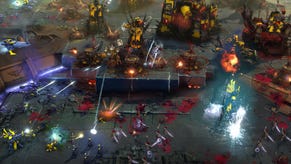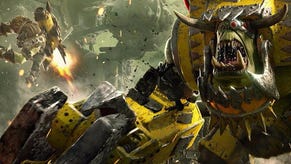Warhammer 40,000: Dawn of War 3: "The grimdark is coming"
Hands-on with Relic's PC RTS.
I've played Warhammer 40,000: Dawn of War 3 for a couple of hours now, and can happily report that it's bloody brilliant.
Dawn of War 3 is a fusion of the first two Dawn of War games. Elements of the base-building and big armies of Dawn of War 1, and elements of the micro-managed heroes of Dawn of War 2, combine to form an immensely satisfying real-time strategy that, based on a couple of playthroughs of a late-campaign mission, feels as weighty and as punchy as any game based on the Warhammer 40,000 universe should, with a zing and responsiveness inspired by the PC's most popular games that emerged in the seven years since Dawn of War 2 came out.
But this concern about the game's new look just won't go away - and with good reason, too.
Let's back up and go through why I think Dawn of War 3 feels great to play. First off, moving Space Marines around and making them blow and carve those space twats the Eldar into bits carries a real impact. Special abilities literally shake the screen. Take Gabriel Angelos, for example. The Blood Ravens commander wields a giant hammer, and doesn't he show it. Everything from his run animation to his cool leap smash attack has been crafted to reinforce the sense that he's carrying around a bloody great heavy hammer that does huge amounts of melee damage. When you pop his smash, the hammer carves cracks into the ground as enemy units are knocked on their backs. Use this special ability to launch Angelos into a squad holed up in one of Dawn of War 3's new cover points for maximum splash damage. Get in.
Then there's the return of base building. Now, it's important to note Dawn of War 3's base building doesn't rewrite the RTS rulebook. It's a relatively simple affair that involves gathering Requisition and Power from Resource Points, plonking down buildings that open up the tech tree in traditional fashion, and expanding your sphere of influence to inch ever closer to the 200 population cap. But despite the simplicity of Dawn of War 3's base building, the mechanic makes a welcome return.
There's something about those downtrodden Servitors that feels perfectly Warhammer 40,000. I loved Dawn of War 2, but I did miss those massive armies made possible by everyone's favourite unsung builder unit. Hey, Servitor, why don't you build me another Doctrine Chapel just because? "This one serves as punishment for [redacted]." Damn straight, you do.

And those big armies, eh? There's a hell of a lot going on on screen in Dawn of War 3 because there's a hell of a lot of soldiers on screen shooting the place up. It's all relative, of course. Dawn of War 3 isn't Supreme Commander. It's not Total War. But, importantly, it's not Dawn of War 2, either.
By that I mean you do feel like you're commanding an army, as opposed to micromanaging a group of incredibly powerful hero units who happen to have taken a few squads and vehicles along for the ride. In Dawn of War 3 you build squads of soldiers and loads of vehicles, such as tanks. Lots and lots of tanks.
So yes, in Dawn of War 3 you can smash up enemy bases with a tank rush. Take that, Dawn of War 2. Or, you can create an army made up of 200 Scout Marines just for the laugh. Or why not a fleet of Land Speeders, which float about the battlefield as if competing in a post-apocalyptic riff on Dancing on Ice? Done and done.
The upshot of Dawn of War 3's bigger armies is there's loads of stuff going on all of the time, which is also great. If it isn't bolter fire that's streaking across the battlefield, it's missiles fired from the towering Imperial Knight Solaria. Her special abilities are just perfect: plant her giant mecha feet into the ground and devastate anything unlucky enough to be caught in the sweeping arc of her twin gatling gun fire, or plant her giant mecha feet into the ground and launch missile after missile into the enemy ranks. There's never a quiet moment in Dawn of War 3, and that's exactly how it should be. There's a lot of warring to be done, after all. This isn't the game for caution. This is the game for painting the battlefield red.
(You can check out a 20 minute supercut of my playthrough of this mission in the video, below.)
You'd expect all this from a Dawn of War game, wouldn't you? None of it comes as much of a surprise, because, well, this is Relic Entertainment and it's Space Marines and Orks and Eldar. Where's the innovation? The hook? The reason to be? Well, it's in the hero units, where Relic's doing something with Dawn of War 3 that reminds me a lot of MOBAs.
There's a big emphasis on hero units, or Elite units, in Dawn of War 3. Gabriel Angelos is one. Imperial Knight Solaria is another. A squad of Assault Terminators is the third I got to play with. To use them on the field you need the corresponding number of Elite Points, which increase as you play. Gabriel Angelos is an ultra cheap Elite, so you can use him from the off. The Assault Terminators are expensive, so the mechanic forces them into late game territory.
And remember, when one of your Elites bites the dust (with Angelos, who packs a punch but has something of a glass jaw, this is bound to happen from time to time) there's a cooldown before you can respawn.
The point is there's a grand strategy to the use of the Elite units in Dawn of War 3 that's unlike anything we've seen in the previous two games.
Here's how it works: as you play the campaign you unlock Elite units. The Dawn of War 3 campaign, unlike the Dawn of War 2 campaign, is linear, and it tells the story from the perspective of each of the three races included at launch: the Space Marines, the Orks and the Eldar. So, you play Space Marines mission one, then mission two you're the Orks, then mission three the Eldar. And so on.
This perspective-shifting campaign lets you take control of a race you've just beaten up in the previous mission, which is a cool hook. But it does mean that the branching campaign of Dawn of War 2, which let you pick your missions, is done away with. As with most design decisions, it was a trade-off.
So, there are more than three Elite units for the Space Marines. I haven't gone hands-on with Librarian Jonah Orion, but he's one. One of the Eldar Elite units is Macha, Farseer of Biel-Tan. Expect plenty more.
You pick your three Elite units to bring on a mission before you start the mission, so you need to be smart about which hero units you pick. There was an element of this kind of mechanic in Dawn of War 2, particularly in the wonderful Last Stand co-op mode, but in Dawn of War 3 there will be many more heroes available to choose from. And unlike Dawn of War 2's hero units, which could loot powerful wargear, customise their loadouts and boost their stats, Dawn of War 3's heroes are fixed characters (Angelos always swings his hammer), who play distinct roles on the battlefield. You can unlock additional passive effects for heroes (Angelos, for example, can heal friendly units when a drop pod is called in), but this is surface level tinkering. Dawn of War 3 feels a lot like Relic dragging Dawn of War kicking and screaming into the popular PC game era, at a time when most reckon the RTS is on its way out.

I haven't touched multiplayer yet, and Relic is saving its discussion of that portion of the game for some future PR beat, but it's safe to say that hero picking is central to Dawn of War 3.
"I'm not going to sit here and tell you I don't pay attention to MOBAs or Overwatch or Team Fortress," Relic game designer Philippe Boulle says.
"But I can honestly say the idea of doing that type of hero-swapping with your army came from the tabletop. That's a key element of the tabletop. Your entire army is built with swappable units, each with point values. There are rules for how you can do it, but there's a whole category called elites. HQ units are big hero units you choose to bring in.
"That's where the original inspiration came from."
Clearly, I enjoy playing Dawn of War 3. But do I enjoy looking at it? Here, things start to get a little murky. Or cartoony, as critics of the series' new art style would say.
I've watched with interest the fascinating debate sparked by Dawn of War 3's gameplay reveal. Our video, below, showcasing Dawn of War 3 gameplay for the first time has nearly as many dislikes as it has likes. Almost all the complaints revolve around the graphics. It's too light and bright, they say. It's not Warhammer 40,000.
In a previous interview Boulle explained Dawn of War 3's new art style, so I won't retread old ground here. But I find fascinating Relic's reaction to the reaction. I wonder whether they saw it coming, whether they understand the debate.
"Looking back at it, I will say that the map we focused on in the early release is the starkest, whitest, bluest map we've done," he says. Boulle's talking about the icy environment in which the mission I play takes place. What he's saying is the map is to Warhammer 40,000 what Toontown was to Who Framed Roger Rabbit? Other environments are... different. One I saw in tech demo-form only had a dark and dangerous feel, a battlefield blackened by, you imagine, the Balrog monster from Lord of the Rings. There's a lava red coursing through the veins of this map, a Dragon's Maw jutting out of every crag. Would the debate have been different if Relic had used this map to unveil Dawn of War 3? Probably.
"The contrast is the sharpest there," Boulle says of the ice map. "Some of the other environments, there's definitely more grimdark there. I don't think people should worry. They're definitely going to get their grimdark.
"It's going to come down to people getting their hands on it. As we get into other environments, the grimdark is going to come."
And yet you can't get away from the sense that Dawn of War 3 is a brighter affair. Yes, the high contrast art style is by design, but it followed a stunning reveal trailer that went about as grimdark as Warhammer 40,000 possibly could. The scene had been set by CGI. Then, the reality of in-game graphics comes as a surprise.
The tradeoffs are understandable and obvious. Decreased detail helps make Dawn of War 3 a more scaleable game. More cartooney graphics, as the critics would say, make for clearer visuals.
"Don't get me wrong, I love me a high fidelity Space Marine," Boulle says, "but we're a game about seeing a whole bunch of these things moving around, not about coming in and looking at the detail on the purity seal on the left ear of your Space Marine."
This "bigger picture over finer details" philosophy perhaps extends to the gameplay, too. Dawn of War 3 lets you build and control a big army, but getting the most out of it is a more streamlined affair than it was in Dawn of War 1.
Your squads are listed in icon form along the bottom of the screen, so you can quickly jump to each. And while squad upgrades return, managing individual soldiers within a squad is restricted. In Dawn of War 1, remember, you could give one Space Marine in a squad a Flamer, for example, and another a Missile Launcher. In Dawn of War 3, you build a Scout Sniper squad separately from a basic Scout squad, and a Devastator Marine squad with lascannons separate from a Devastator Marine squad with heavy bolters. It looks like only the flexible Tactical Marine squad that can upgrade its weaponry, on the Space Marine side of things, anyway.
There's only so much you can tell about a game from playing a single mission, even if you've played it twice. But I feel confident that Dawn of War 3 is on the right track and feels right, even if it looks very different. I'm looking forward to seeing new environments, new vibes and new Elite units. And, in particular, I'm looking forward to seeing Dawn of War 3's Orks, or, as Relic calls them, Warhammer 40,000's intergalactic football hooligans.
I can't wait.
















.png?width=291&height=164&fit=crop&quality=80&format=jpg&auto=webp)



